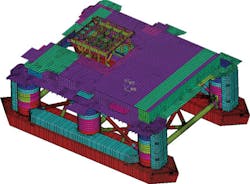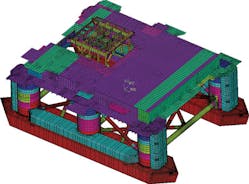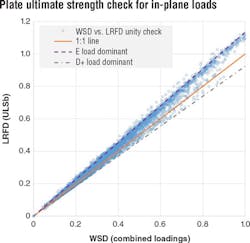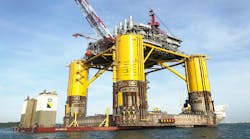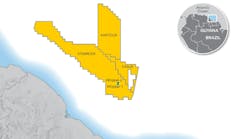New requirements developed in response to evolving practices
Qing Yu
ABS
Offshore structures have to be designed for safety, but defining safety criteria presents challenges. While there is universal agreement that safe structures are critical, it also is important to avoid over-designing.
Then and now
The offshore industry historically has used the Working Stress Design (WSD) method, also known as the Allowable Strength Design (ASD) method, to design offshore structures. US standards for offshore structures, developed through the American Petroleum Institute (API), are based on the WSD method and have been used worldwide for decades.
The recent introduction of the new ISO 19900 series of standards for offshore structures has lessened dependence on the US standards, which are being replaced with the Load and Resistance Factor Design (LRFD) method or, in ISO’s terminology, the Partial Factor method. Today, this is the primary design method in ISO standards for both fixed and floating offshore structures.
The most apparent difference between WSD and LRFD is that the WSD method uses a single safety factor regardless of load types, while LRFD defines a set of partial safety factors for categorized load components such that a higher safety factor can be applied to a load that is less well defined and has greater uncertainties. Although the LRFD method is considered conceptually more advanced - and is one step closer to the reliability-based design that aims to achieve a consistent level of safety - there is a long history of industry debate about the real advantages of the LRFD method.
Many arguments focus on how load combinations and partial safety factors are derived. They are determined based either on calibrations against established WSD-based criteria or by using reliability analysis when a target reliability level is known. The former raises the question about the necessity of the LRFD method as it appears to merely match the design obtained from the traditional WSD method. The latter is concerned with the difficulty of defining a target reliability level that often is an unknown. Another issue some have with the LRFD method is its application to mooring lines, risers, TLP tendons, and foundation designs, where the separation of load categories to which different partial safety factors could be applied is not straightforward.
In the 1980s, API initiated the first attempt to develop LRFD-based design criteria for fixed platforms. The result was the first edition of API RP 2A-LRFD, published in 1993. Application of this API standard is very limited in the US, and the document remained largely unchanged from its initial publication until ISO TC67/SC7 used it as the base document for developing an ISO standard for fixed platforms.
In 2007, the first edition of ISO 19902 for fixed platforms was published, and ISO 19904-1 for floating offshore structures was also developed. In 2010, the first edition of ISO 19901-3 was published for topsides structures along with ISO 19906 for Arctic offshore structures. ISO 19905-1 was developed on the basis of SNAME TR Bulletin 5-5A for jackups, with its first edition published in 2012. All of these ISO standards are LRFD-based, although ISO 19904-1 specifically includes the WSD-based criteria as an alternative. In the US, several new editions of API standards for offshore structures have been developed or are under development based on the ISO 19900 series of standards. This chronology illustrates how ISO standards are forming the foundation of future national standards and regulations.
Participating in discussions in various ISO workgroups over the years, ABS recognized that design practices are evolving, and began to develop LRFD-based classification requirements for offshore structures with the objective of establishing a set of LRFD-based structural design criteria that can be used as an alternative to existing classification criteria.
Value of LRFD
Conceptually, the LRFD method is considered to be a more rational approach and is a step closer to a reliability-based design if load categorization and load combination are achievable, calibrations are made against a common base, and nonlinearity is appropriately addressed.
With these requirements in mind, ABS initiated a project to develop the ABS LRFD criteria for offshore structures. The study used representative mobile offshore drilling units (MODU) and floating production installations (FPI) to verify that the LRFD criteria being developed could be used to produce a design that is globally comparable to a design obtained from WSD criteria.
One of the main advantages of using LRFD-based design criteria is the ability to apply a higher safety margin in the form of a higher partial safety factor to a design parameter that is considered less predictable or that could have a negative impact on the design. This allows for a more explicit way of taking into account uncertainties carried by design parameters. Several methods commonly are used to determine the values of partial safety factors. One is to calibrate against the existing WSD design criteria, which was done in this study. Another is to define a target reliability level and use structural reliability analysis to determine partial safety factors, and a third is to use the combination of these two approaches.
Verifying the methodology
A segment of the study used a twin-hull column-stabilized drilling unit for load and global strength analysis in both normal drilling conditions and in a severe storm environment. Using proprietary software, the team evaluated 18 design waves that produced the maximum longitudinal shear forces, prying forces, and torsional moments with a design code check performed for various limit states for structures.
The results showed that the LRFD criteria and the WSD criteria compared well in the case of the plate yielding and stiffener and girder buckling unity checks, although the LRFD criteria tend to be slightly more conservative than the WSD criteria when the environmental loads govern. The degree of conservativeness depends on the relative contribution of permanent and variable loads and environmental loads in the load combination. In addition, because the basic scantling requirements are essentially the same, the difference in the design code check due to the use of the LRFD and WSD strength criteria becomes irrelevant when the basic scantling requirements govern the design.
For the column-stabilized drilling unit considered in the verification, results demonstrate that the goal of developing alternative LRFD criteria that are comparable to existing WSD criteria has been achieved. Other observations include the fact that under static conditions, there is an approximate 9% reduction in the strength design requirement in the LRFD criteria that appears to have no significant impact on the structural integrity given the safety factor of 1.43 for the plate yielding check and 1.67 for the stiffened panel buckling and ultimate strength in the current ABS WSD criteria.
For the combined load condition, LRFD criteria tend to be slightly more conservative than WSD strength criteria, particularly when the environmental loads become dominant. This trend is observed for both yielding and buckling assessment for plates, stiffeners and girders. For a structural component whose design is determined by environmental loads, the increase in the strength requirement in the proposed LRFD potentially could reach 11% in the yielding check and 13% in the buckling and ultimate strength check. There are scenarios, however, in which the permanent and variable loads outweigh environmental loads to the extent that the new LRFD strength criteria are less stringent than the WSD strength criteria.
For cases where the static load condition governs the design, the estimated reduction in strength requirement in the LRFD criteria for the combined load conditions is roughly 5% in the yielding check and 3% in the buckling and ultimate strength check. Given the safety factor of 1.11 for the plate yielding check and 1.25 for the stiffened panel buckling and ultimate strength in the current ABS WSD criteria, such a reduction does not affect overall structural integrity.
Similar verification work was done using a jackup and a column-stabilized FPI with a triangular shape hull consisting of three pontoons - each with a rectangular cross section made of stiffened plate panels - three columns, a column top frame and a non-integrated topside deck. The two ultimate limit states (ULS) associated with the design operation condition (DOC) and design environmental condition (DEC) were studied to compare the LRFD and WSD criteria for various structural components (tubular members, plates, stiffeners, girders and cylindrical shells). Three design waves and two wave approach directions for each design wave (totaling 12 analysis cases) were defined for the global strength analysis for each ULS.
The study concluded that yielding and buckling assessments using the LRFD criteria are in good agreement with those using the current WSD criteria and that the LRFD criteria for column-stabilized installations are equivalent to, or slightly more conservative than, the WSD criteria for environmental load dominant conditions, but slightly less conservative than the WSD criteria for gravity load dominant conditions. This reflects a common trend of LRFD criteria, which apply a higher safety margin to environmental loads with a greater uncertainty and a lower safety margin to more predictable gravity loads. A similar trend was observed in the verification of LRFD criteria for MODUs.
The result of this three-year development effort is the establishment of LRFD structural design criteria for specific types of offshore structures confirmed through extensive verification against existing WSD criteria. This information was used to create two new ABS Guides that introduce an alternative to the traditional approach to design.
Continuing efforts
While the verification of the LRFD method has concluded, work continues. One project aims to compare the results of this study with similar studies carried out by other organizations. Because of the close connection between LRFD-based criteria and structural reliability, there are still questions regarding the intended safety level in terms of a reliability index or allowable failure probability of the new criteria. This has led to a decision to conduct structural reliability analysis in support of future development of the ABS LRFD criteria.
Acknowledgement
Based on a paper (OTC-27225-MS) presented at the Offshore Technology Conference held in Houston, Texas, May 2-5, 2016.
